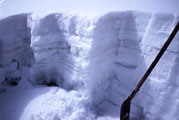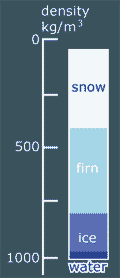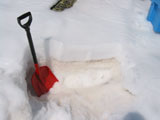 |
|
|
|
|
|
|
The structure and texture of a snow cover undergoes continuous alteration, referred to as metamorphism. This continuous alteration of the snow occurs due to the thermodynamic instability of the solid grains at temperatures near phase change. Energy and vapour pressure gradients as a consequence of temperature differences in the snow cover are additional activators of change. Before this process begins snow crystals undergo often mechanical destruction by strong wind. |
||||
|
crystals |
round forms |
edged forms |
||
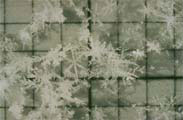 |
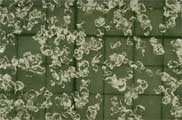 |
 |
||
 |
 |
|||
|
destructive metamorphosis |
constructive metamorphosis |
|||
|
2a, b and c - Metamorphosis of newly fallen snow flakes from crystal forms into round grains (destructive metamorphosis) and edged grains (constructive metamorphosis). The driving forces of metamorphosis are differences in temperature, humidity and pressure in the snow cover. |
||||
|
During destructive metamorphism snow grains change from crystal to round forms, whereas during constructive metamorphosis round grains change into edged forms. Constructive metamorphism is a result of vapour transfer from the warmer bottom to the colder top of the snow cover. The end product of this type of metamorphosis, depth hoar, is associated with a decrease of mechanical strength and an increase in air-filled hollows. Depth hoar can build up a layer with low stability within a snow cover. This unstable layer can cause a snow drift and result in an avalanche. At the end of this metamorphosis freezing and thawing processes by temperatures near 0°C can thaw little exposed crystals. At the same time ice attaches at the periphery of the other crystals and big round grains can form (firn). |
||||
|
Why are (hidden) depth hoar and persistent instabilities typical characteristis of a region with a continental climate? |
|
Density of snow |
|||||||||||||||
|
The composition of layers and the form of snow grains determines the density of snow, which in turn defines important snow characteristics such as radiation extinction, temperature conductivity, or load. The density of snow varies approximately between 50 and 500 kg/m3, depending on the distribution of the elements of snow, ice, air and water. |
Density profile
|
Snow types and corresponding values of density
|
|||||||||||||
|
|
3 - The change from snow to ice occurs at densities greater than 800 kg/m3. | ||||||||||||||
|
|
|
Snow harbors a variety of chemical elements. These substances are of both natural and anthropogenic origin, may be brought in as dry or wet deposits, and include organic compounds and/or microbial products. The biological influence on chemical composition depends on: |
|
|
Sahara dust |
|
4 - A layer of Sahara dust on the snow surface (November 2002). The high calcium concentration of Saharan dust is an important mineral source for microorganisms such as snow algae. (24K) |
Strong winds from the south can cause high precipitation in the Alps (south side and sometimes north side). The wind starts in North Africa (Scirocco) and on occasion transports dust from the Sahara (and possibly Spain). The sand has a red or yellow-brown color and serves as a marker in the snow profiles because the exact data of precipitation is known. In spring-time when the snow cover is wetter the dust particles begin to percolate downwards. If snow is acid, sand can have a neutralizing effect. Sahara dust layers have a general tendency to become encrusted superficially due to the fact that this layer begins to melt faster than white snow. Contact with snow layers deposited later is often poor, so that avalanches may release. |
5 - This bared Sahara dust layer has a thickness of c. 15cm and is covered by new snow. (52K) |
|
Typical aerosols in the snowpack are calcium (Ca2+) brought in by Sahara dust, sodium (Na+) and chloride (Cl-) from the sea, ammonium (NH4), nitrate (NO3) and sulphate (SO4) predominantly from such anthropogenic sources as traffic, power stations and agriculture. Chemical species such as calcium are of importance for the activity of microorganisms in the snow. |
|
||||||||||||||||||||||||||||||||||||||||||||||||||||||||||||
|
6 - Concentration of macroelements and ions in the meltwater of snow. The values are averages of samples collected at ten different sites throughout the Swiss alps in march 2000. At each sample site, three to seven probes of 0.5 L snow were sampled. |
29 August 2011 |
||
| |
||

